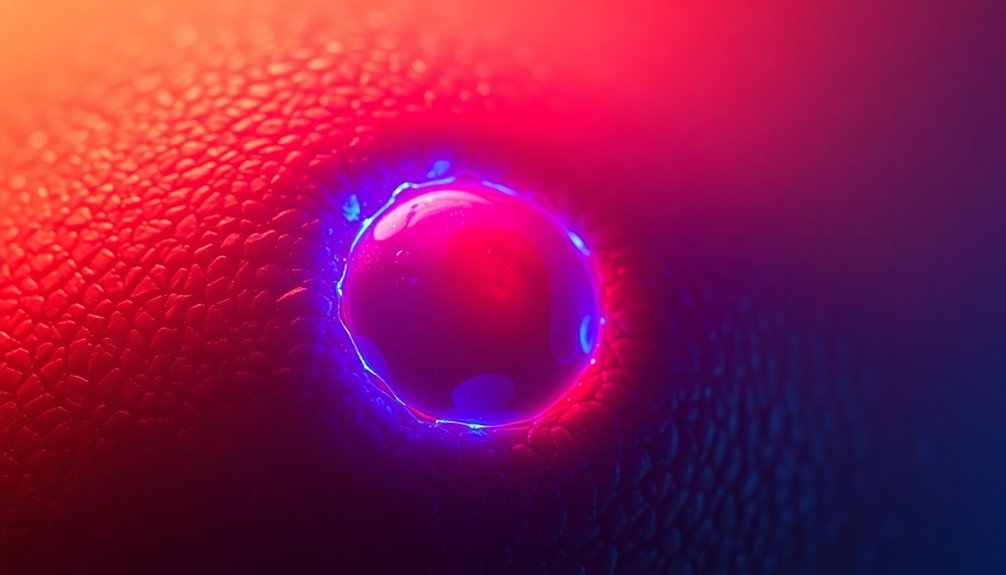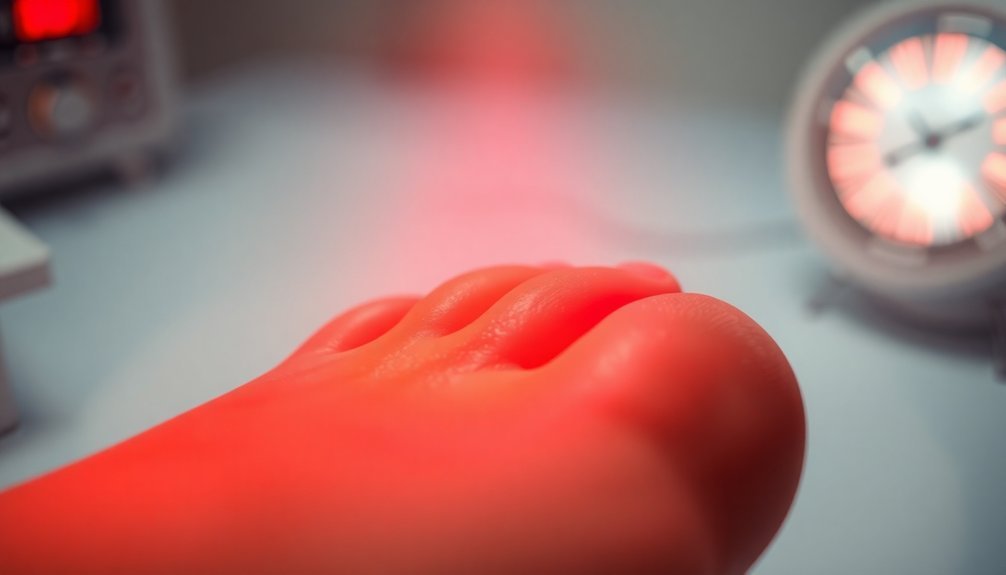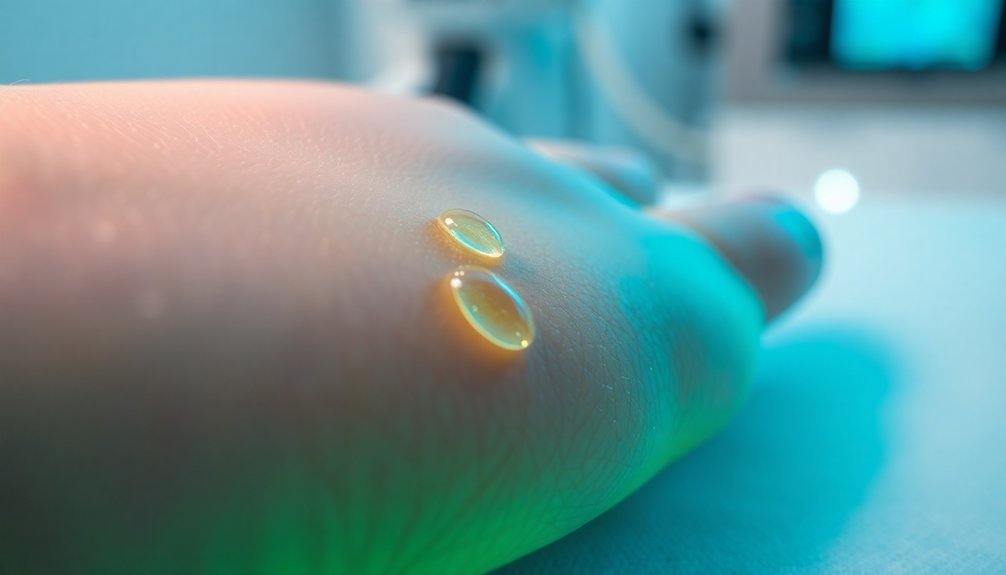To effectively treat diabetic wounds, you should consider these five wavelengths: 633 nm, which boosts healing by 38.5% and promotes collagen production; 635 nm, enhancing cell viability and differentiation; 660 nm, reducing inflammation and accelerating wound recovery; 810 nm, which facilitates deep tissue penetration and cellular migration; and 670 nm, known for its lower inflammatory responses. Each wavelength plays an essential role in improving tissue regeneration and minimizing healing time. By exploring these options further, you'll uncover even more insights into maximizing wound healing strategies.
633 Nm Wavelength Benefits

When it comes to promoting healing in diabetic wounds, which wavelengths of light really make a difference?
You'll want to pay close attention to a few specific wavelengths that have shown significant benefits. Red light, particularly at 633 nm, stands out with a remarkable 38.5% improvement in wound healing. By using an ideal energy density of 2.35 J/cm², and applying it three times a week, you can reduce healing time from 40-60 days down to just 21 days. Red light therapy has been shown to increase collagen synthesis and granulation tissue formation, further enhancing the healing process.
Near infrared light, especially at 810 nm, also plays a vital role. Working at low power densities (0.1 W/cm²) with a total output energy of 5 J/cm², it improves mitochondrial respiration and reduces oxidative stress, promoting quicker healing through increased fibroblast and collagen activity.
Meanwhile, green light (540 nm) provides some positive effects as well, particularly in increasing wound perfusion, though it's not as effective as red or near infrared light. It can serve as an alternative if red light isn't accessible.
Unfortunately, blue light (470 nm) doesn't offer any significant benefits for diabetic wound healing, making it a less useful choice.
635 Nm Wavelength Effects
What specific effects do different wavelengths of light have on wound healing? Each wavelength plays a unique role.
For instance, red light (620-750 nm), particularly at 660 nm, markedly boosts cell viability, migration, and proliferation. You'll notice that its capacity to differentiate fibroblasts into myofibroblasts can accelerate healing, especially when using a fluence of 5 J/cm². This is particularly important as 25% of diabetic patients develop DFUs, making effective treatments crucial.
On the other hand, near-infrared (NIR) light (780-950 nm) penetrates even deeper into tissues. You'll find that NIR light at 830 nm enhances cell migration and viability while reducing oxidative stress. Its ability to increase antioxidant activity is vital for managing diabetic wounds.
Green light (540 nm) offers some benefits when applied in pulsed therapy, showing positive effects on wound healing, though not as substantial as red or NIR light.
Blue light (470 nm), however, is generally ineffective for diabetic wounds.
In essence, red and NIR light emerge as robust choices for treating diabetic wounds, highlighting the significance of selecting the right wavelength for effective photobiomodulation outcomes.
660 Nm Wavelength Advantages

Several wavelengths of light offer distinct advantages for wound healing, making them essential in treating diabetic wounds. Among these, both red and near-infrared (NIR) lights stand out for their effectiveness in stimulating cellular processes critical to wound recovery.
Consider the following advantages of these wavelengths:
- Enhanced Healing: Red light, especially around 660 nm, accelerates fibroblast differentiation, reduces pro-inflammatory cytokines, and boosts cellular viability. This is crucial because impaired proliferation in diabetic patients negatively affects the wound healing process.
- Deeper Penetration: NIR wavelengths, such as 830 nm, allow for deeper tissue penetration, promoting collagen production and better blood flow.
- Optimal Energy Densities: Effective ranges between 3-6 J/cm² for red and 5 J/cm² for NIR guarantee positive effects on healing without the risk of bioinhibition.
These attributes not only reduce wound size and improve perfusion but also enhance the overall healing process.
810 Nm Wavelength Outcomes
Understanding the outcomes associated with different wavelengths can help you optimize treatment for diabetic wounds. At 633 nm, studies show a 38.5% improvement in diabetic wounds and up to 53.4% for burns when applying a fluence of 4.71 J/cm² three times a week. This wavelength not only boosts collagen production but also reduces inflammation and enhances vascular endothelial growth factor (VEGF).
Moving to 660 nm, you'll find increased cellular viability and accelerated fibroblast differentiation, promoting wound healing. Effective at a fluence of 5 J/cm², this wavelength decreases pro-inflammatory cytokines, which is crucial for recovery.
At 670 nm, histopathological analysis reveals lower inflammatory responses and enhanced collagen production with proper treatment. A 15-day irradiation period shows positive results when utilizing a power density of 30 mW/cm².
Finally, at 830 nm, near-infrared light penetrates deeply, considerably boosting cellular migration while modulating the TGF-β/Smad pathway, which encourages healing. Just like the previous wavelengths, it achieves its effects with a fluence of 5 J/cm².
Each of these wavelengths offers distinct benefits to enhance the healing process for diabetic wounds.
General Red Light Insights

Red light therapy's effectiveness in promoting healing stems from its ability to penetrate the skin and stimulate cellular processes. By shining low-power red and near-infrared wavelengths, this non-invasive and painless treatment reaches depths of about 8 to 10 millimeters.
It works through photobiomodulation, enhancing cellular energy and metabolism, which plays a crucial role in wound healing.
Here are some key benefits of red light therapy:
- Boosts Cell Activity: It enhances cell proliferation, migration, and adhesion, promoting faster wound closure.
- Collagen Production: The therapy increases collagen synthesis, essential for tissue regeneration, making it indispensable for healing diabetic wounds.
- Reduces Pain and Inflammation: By releasing endorphins and modulating pain receptors, red light therapy alleviates discomfort and curtails inflammation.
The clinical outcomes are impressive, with studies showing faster healing rates and increased granulation tissue in treated wounds compared to traditional methods.
Plus, red light therapy carries minimal risk as it has no reported side effects. Embracing this innovative treatment could transform your wound healing process and improve your quality of life.
Frequently Asked Questions
How Long Should Each Laser Treatment Session Last?
Each laser treatment session generally lasts around 80 seconds to 2 minutes, depending on the wound's size. Short sessions can be applied multiple times a week for ideal healing, tailored to your specific needs.
Can Laser Therapy Be Combined With Other Treatments?
Yes, you can combine laser therapy with other treatments. Integrating it with traditional methods, like glycemic control and wound dressings, enhances healing, reduces inflammation, and improves overall recovery outcomes for diabetic wounds. It's effective together.
Are There Any Side Effects of Using Laser Therapy?
Yes, you might experience some side effects from laser therapy, like redness, swelling, or mild discomfort. It's crucial to contemplate any medications you're on and discuss any concerns with your healthcare provider.
How Soon Can I Expect to See Results?
You can expect to see results within the first week, as many report significant wound area reduction and enhanced healing rates shortly after starting treatment. Results may become even more notable within three weeks.
Is Laser Therapy Safe for All Diabetic Patients?
Yes, laser therapy is generally safe for diabetic patients. It's non-invasive with minimal side effects. However, make certain a trained professional administers the treatment and follow proper protocols to maximize safety and effectiveness during your sessions.
In Summary
To sum up, choosing the right wavelengths—like 633 Nm, 635 Nm, 660 Nm, and 810 Nm—can make a significant difference in treating diabetic wounds. Each wavelength offers unique benefits and outcomes tailored to enhance healing. By incorporating these specific light therapies into your treatment plan, you can potentially accelerate recovery and improve overall wound health. Remember, understanding these insights can empower you to make informed decisions for better results. So, don't overlook the power of light in healing!





Leave a Reply